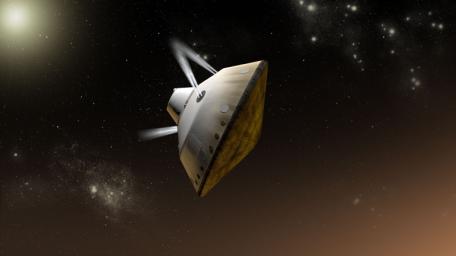Mars Science Laboratory Guided Entry at Mars, Artist’s Concept
Caption:
This artist's concept shows thrusters firing during the entry, descent and landing phase for NASA's Mars Science Laboratory mission to Mars.
The entry, descent, and landing (EDL) phase begins when the spacecraft reaches the Martian atmosphere, about 81 miles (131 kilometers) above the surface of the Gale crater landing area, and ends with the rover safe and sound on the surface of Mars.
Entry, descent, and landing for the Mars Science Laboratory mission will include a combination of technologies inherited from past NASA Mars missions, as well as exciting new technologies. Instead of the familiar airbag landing of the past Mars missions, Mars Science Laboratory will use a guided entry and a sky crane touchdown system to land the hyper-capable, massive rover.
The new entry, descent and landing architecture, with its use of guided entry, will allow for more precision. Where the Mars Exploration Rovers could have landed anywhere within their respective 93-mile by 12-mile (150 by 20 kilometer) landing ellipses, Mars Science Laboratory will land within a12-mile (20-kilometer) ellipse! This high-precision delivery will open up more areas of Mars for exploration and potentially allow scientists to roam "virtually" where they have not been able to before.
In the depicted scene, thrusters on the backshell of the spacecraft's aeroshell are firing to adjust the orientation of the spacecraft during the guided entry maneuvers. The rover (Curiosity) and the spacecraft's descent stage are enclosed inside the aeroshell during this passage through the upper atmosphere of Mars.
Background Info:
The Mars Science Laboratory spacecraft is being prepared for launch during Nov. 25 to Dec. 18, 2011. Landing on Mars is in early August 2012. In a prime mission lasting one Martian year (nearly two Earth years) researchers will use the rover's tools to study whether the landing region has had environmental conditions favorable for supporting microbial life and for preserving clues about whether life existed.
NASA's Jet Propulsion Laboratory, a division of the California Institute of Technology, Pasadena, Calif., manages the Mars Science Laboratory Project for the NASA Science Mission Directorate, Washington.
More information about Curiosity is at
http://mars.jpl.nasa.gov/msl/
.
Cataloging Keywords:
| Name |
Value |
Additional Values |
| Target |
Mars |
|
| System |
|
|
| Target Type |
Planet |
|
| Mission |
Mars Science Laboratory (MSL) |
Mars Exploration Rover (MER) |
| Instrument Host |
Curiosity Rover |
|
| Host Type |
Rover |
|
| Instrument |
|
|
| Detector |
|
|
| Extra Keywords |
Artwork, Atmosphere, Color, Crater |
| Acquisition Date |
|
| Release Date |
2011-10-03 |
| Date in Caption |
|
|
| Image Credit |
NASA/JPL-Caltech |
| Source |
photojournal.jpl.nasa.gov/catalog/PIA14834 |
| Identifier |
PIA14834 |

 Planetary Data System
Planetary Data System
